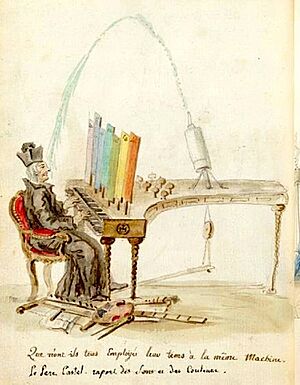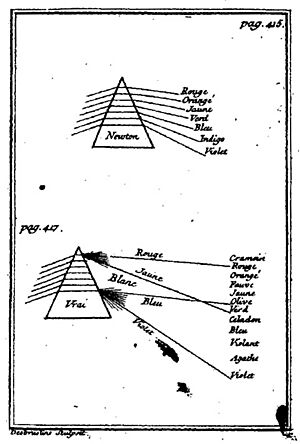Louis Bertrand Castel facts for kids
Louis Bertrand Castel (born November 5, 1688 – died January 11, 1757) was a French mathematician. He was born in Montpellier and joined the Jesuits in 1703. After studying literature, he focused completely on mathematics and natural philosophy (which was like science back then). In 1720, he moved from Toulouse to Paris. There, he became the science editor for the Jesuit magazine Journal de Trévoux.
Castel wrote several science books. His most famous one was Optique des couleurs (1740), which was about the "melody of colors." He also wrote Traité de physique sur la pesanteur universelle des corps (1724) and Mathématique universelle (1728). In 1743, he wrote a critical review of Sir Isaac Newton's ideas.
Contents
Castel's View on Science
Castel wrote about many different subjects, including physics, mathematics, and even art. He tried to connect different ideas and fields of study. He believed that true science should focus on things we can easily see and describe.
He thought that understanding the world meant finding similarities, or "analogies," between different things. Castel did not like the idea of science based only on experiments, special tools, or guessing. Instead, he preferred to describe and analyze what people could actually experience.
The Amazing Ocular Harpsichord
Castel used his ideas about colors to create a special instrument called the Clavecin pour les yeux, which means "Ocular Harpsichord" or "Eye Harpsichord." He first suggested this idea in 1725. More articles about it in 1735 made his invention widely known.
In 1739, the German composer Georg Philipp Telemann traveled to France just to see Castel's Ocular Harpsichord. Telemann even wrote music for it and described how it worked.
The first Ocular Harpsichord had 60 small pieces of colored glass. Each piece had a curtain that would open when a key was pressed. A better version of the harpsichord was shown in 1754. When a key was pressed, a small opening would appear, letting light shine through a piece of stained glass. Castel believed that color-music was like a lost language from paradise, where everyone understood each other. He even claimed that his instrument could "paint sounds," allowing deaf people to enjoy music!
Why Castel Disagreed with Newton on Colors
In 1740, Louis Bertrand Castel wrote a book that disagreed with Sir Isaac Newton's ideas about how a prism splits white light into colors. Castel noticed that the colors you saw from a prism changed depending on how far away you were from it. He thought Newton was only looking at a special case. Later, the famous writer Goethe developed this idea further in his own Theory of Colours.
See also
 In Spanish: Louis Bertrand Castel para niños
In Spanish: Louis Bertrand Castel para niños
- Color organ




